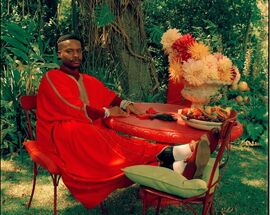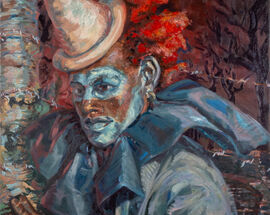Athi-Patra Ruga: 'Amadoda on the Verge…' at BKhz Gallery
Aug 31 - Nov 9 2024
Keyes Art Mile, 21 Keyes Ave, Rosebank
In a series of luscious, layered paintings, Athi-Patra Ruga creates avatars that probe the influence of historical tropes on agency and representations of black masculinities. "I welcome you to a part-speculative, part-historical frontier in which complex notions of collaboration and conflict between settler and native, coloniser and colonised are reflected in the sartorial choices of my avatars," says the artist.
"The decay and ruin of the memorials and military forts in my native Eastern Cape has drawn my attention to a lapse in our collective memory," Ruga continues. "It has awakened my need to revisit the geography of the South African colonial frontier and explore the military fort as a microcosm of frontier encounters. The Eastern Cape, which was a fiercely contested battleground, indicates a significant collective loss and has prompted me to offer up a counter-narrative to eulogise that which has been overlooked and omitted."
Ruga's lone avatars appear to be on the verge of something curious and uncharted. The uneasiness of the "frontier", both as a physical and psychological limit, as well as a threshold for new opportunities, fascinates him. In his work, Ruga draws inspiration from historical flash points like the Crimean War, sightings of Halley's Comet, and the publication of Frankenstein, aesthetically bridging the Neo-Gothic sensibility prevalent in the architecture and literature of the frontier period and the sombre atmosphere of the present-day Eastern Cape.
"The dark history of settler occupation and religious domination has inspired me to focus on the continued effects of disembodiment on the black male body," says Ruga. "Using costume and craftsmanship, I want to create a remedy, an alternative to a history of loss and disassociation."
In the painting Dyani Mfengu on the Kei River [1835], Ruga depicts a young man who is part of the Mfengu Levy – a group of 17,000 black pioneers who crossed the Nciba (also known as Kei) River, allied with the British against the Xhosa, and who swore allegiance to the British Crown. "They were instrumental in winning several decisive victories for the British," Ruga explains. "The term 'impambano', meaning a schism between the body, mind, and spirit, is referenced allegorically in the character’s combination of attire. This clash of British, Boer, and Xhosa is referenced in clothes salvaged from the battlefield. In the painting, I have suggested a split between the known and the unknown. The assailant is deliberately split from the frame as I reconcile my personal history."
Ruga is a virtuoso of multiple disciplines and, in this body of work, his use of oil paint on canvas is a conceptual choice that positions his work within the long tradition of historical painting. As the exhibition text makes clear, Ruga's work "posits a counter-narrative that re-centres the black sitter and the complexity of these colonial encounters". His characters are a lens through which he re-examines South Africa's fraught colonial history, digs into its continued impact on the present, and proposes a unique vision for the future.
Amadoda on the Verge… [1835–2025] shows at BKhz Gallery at Keyes Art Mile from Sat, Aug 31 – Sat, Nov 9.
Date
Venue
Mon, Tue, Wed, Thu, Fri 10:00–17:00, Sat 10:00–15:00, Closed Sun.
Aug
31
2024
- Nov
9
2024
BKhz Gallery
Keyes Art Mile, 21 Keyes Ave, Rosebank
Keyes Art Mile, 21 Keyes Ave, Rosebank






